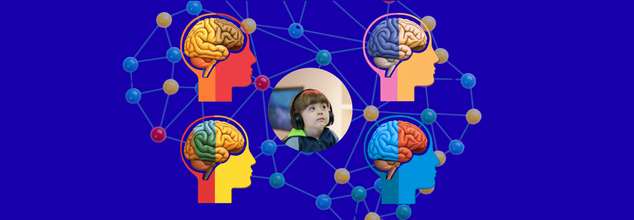- Health Conditions A-Z
- Health & Wellness
- Nutrition
- Fitness
- Health News
- Ayurveda
- Videos
- Medicine A-Z
- Parenting
- Web Stories
Your Brain Age Can Predict How Long You’ll Live, New Study Links ‘Aged’ Brain To Early Death

Credits: Health and me
We mark age by birthdays, but inside our bodies, every organ is on its own clock. And according to new research out of Stanford University, your brain’s biological age might be the best single predictor of how long you’ll live.
The study, published in Nature Medicine, examined over 44,000 adults aged 40 to 70 using a blood test that assesses biological aging across 11 organs. Among all, the brain stood out. Individuals with biologically "younger" brains lived significantly longer—and were far less likely to develop diseases like Alzheimer’s—than those with “aged” brains, regardless of their chronological age.
Researchers at Stanford Medicine analyzed data from the UK Biobank, using a unique blood test that assesses protein signatures—molecules in the blood produced by specific organs. By matching these protein levels to organ-specific aging profiles, they generated biological age scores for 11 systems, including the brain, heart, lungs, kidneys, liver, immune system, and more.
What they found was clear: the more aged your organs are biologically, the higher your risk of disease and premature death. But among all organs studied, the brain’s age had the strongest correlation with longevity.
Participants with “extremely aged” brains—defined as those in the top 7% of biological aging for their chronological age—were nearly twice as likely to die within the next 15 years as those with average-aged brains. On the flip side, people with “extremely youthful” brains had a 40% lower risk of dying in that same period.
“The brain is the gatekeeper of longevity,” said Dr. Tony Wyss-Coray, lead neuroscientist on the study. “If you've got an old brain, you have an increased likelihood of mortality. If you've got a young brain, you're probably going to live longer.”
The implications go beyond just living longer—they also relate to quality of life. Participants with youthful brains had a 74% lower risk of developing Alzheimer’s, while those with aged brains were over three times more likely to receive a diagnosis.
This suggests that tracking biological brain age could be a powerful tool for predicting and potentially preventing neurodegenerative diseases.
How Does Brain Aging Happen and Can We Slow It Down?
Several lifestyle and environmental factors may accelerate brain aging. These include:
- Chronic stress
- Poor diet
- Lack of sleep
- Sedentary behavior
- Excess alcohol or drug use
- Unmanaged health conditions like obesity or hypertension
On the flip side, regular physical activity, a balanced diet rich in omega-3s and antioxidants, quality sleep, social connection, and lifelong learning have all been associated with better cognitive outcomes and reduced brain aging.
There’s also emerging evidence that certain medications, supplements, or even dietary patterns may help preserve brain youthfulness—but more research is needed.
Currently, most people go to the doctor only when something feels wrong. But Dr. Wyss-Coray and his team envision a future where aging biomarkers guide proactive interventions—years before disease appears.
“We’re trying to shift from sick care to health care,” he explains. “We want to intervene before people develop organ-specific disease.” In practice, this could look like:
- Annual blood tests tracking organ-specific biological ages
- Earlier screenings for Alzheimer’s, cardiovascular disease, or cancer
- Tailored lifestyle plans to target the most at-risk organs
- Use of approved drugs to “rejuvenate” aging organs
While still in development, the team believes this test could be commercially available within 2–3 years, focusing first on the brain, heart, and immune system—the organs most closely linked to age-related disease and death.
Perhaps the most important insight from this study is that aging isn’t uniform. You could be 55 on paper, have the heart of a 40-year-old, but the brain of a 70-year-old—and that brain age may be what ultimately determines your health trajectory.
One in four people in the study had at least one “extremely aged” or “extremely youthful” organ, and many had multiple. That level of variation highlights the importance of individualized assessment over blanket assumptions about health based solely on chronological age.
What Can You Do Right Now To Stop This?
While the science is still evolving, here are steps you can take today to support a healthier, more youthful brain:
Stay mentally active: Read, learn, play memory games
Exercise regularly: Aim for at least 150 minutes of moderate aerobic activity per week
Get quality sleep: 7–9 hours a night, consistently
Eat brain-friendly foods: Leafy greens, fatty fish, berries, nuts, whole grains
Manage stress: Try mindfulness, yoga, or breathwork
Avoid toxins: Limit alcohol, quit smoking, monitor environmental exposures
Stay socially engaged: Connection matters as much as cognition
This new research adds to a growing body of evidence suggesting that the state of your brain today can forecast the state of your future health. While birthdays will always mark the passage of time, science may soon give us a much deeper—and more actionable—way to measure how well we’re really aging. In the near future, checking your “brain age” might be as routine as getting your cholesterol tested. And it could change everything about how we approach aging and longevity.
Arizona Resident Dies Of Bubonic Plague Only 24 Hours After Showing Symptoms, All About The Rare Case

Credits: Canva
A sudden and tragic death in Northern Arizona has jolted both local officials and public health experts. A resident died from the plague within just 24 hours of showing symptoms, marking one of the rare but serious instances of the disease in the United States. The person, who has not been publicly identified, was rushed to Flagstaff Medical Center in critical condition but succumbed the same day. An autopsy confirmed the presence of Yersinia pestis, the bacterium responsible for plague.
The case has sparked renewed concern, especially as it occured at the same with a reported die-off of prairie dogs near Flagstaff, an ecological warning sign that the plague may be spreading through local wildlife.
Though it’s often associated with the Black Death of the 14th century, which wiped out millions in Europe, plague is far from extinct. In fact, it continues to appear in small pockets across rural parts of the western United States—including areas of Arizona, New Mexico, and Colorado.
According to the CDC, the U.S. reports an average of seven human plague cases annually. Most of them are bubonic plague, and the disease remains treatable with antibiotics—if caught in time.
The recent Arizona case is a stark reminder of how fast and fatal plague can be if untreated. Coconino County health officials said symptoms can appear within 1–8 days of exposure, and immediate medical care is essential to survival.
While officials have withheld the identity and demographic details of the deceased, their rapid deterioration has been linked to an ongoing investigation into unusual prairie dog deaths northeast of Flagstaff. These rodents, commonly found across the Southwest, are known to harbor fleas that can transmit Yersinia pestis.
“Prairie dogs are highly susceptible to plague but are not considered long-term reservoirs of the disease,” the county stated. However, their die-off is often the first sign that plague is circulating in the environment.
Authorities are working with private property owners to collect flea samples from affected areas. So far, no other human cases have been confirmed.
What Is Yersinia pestis?
Yersinia pestis is a highly infectious bacterium that causes plague. It spreads primarily through bites from infected fleas or direct contact with infected animals, especially rodents. Humans may also become infected through handling contaminated animal tissues or inhaling respiratory droplets from an infected person or animal.
Despite its ancient roots, modern plague is very much a public health concern and if left untreated, it can quickly escalate into a medical emergency.
3 Forms of Plague
Plague manifests in three distinct ways, depending on how the infection spreads in the body:
Bubonic Plague
The most common form, often spread by flea bites. Symptoms include fever, chills, extreme fatigue, and painful, swollen lymph nodes (called buboes). If treated promptly with antibiotics, survival rates exceed 90%.
Septicemic Plague
This form affects the bloodstream and can arise from untreated bubonic plague or direct infection. It’s more severe and presents with symptoms such as abdominal pain, bleeding under the skin, and tissue death—often turning fingers, toes, or the nose black. Left untreated, it is often fatal.
Pneumonic Plague
The rarest and most dangerous form, pneumonic plague infects the lungs. It can be transmitted from person to person through airborne droplets, making it the only contagious form. Symptoms include fever, chest pain, cough, and difficulty breathing. Without treatment, it progresses rapidly and is often fatal.
In the Arizona case, the resident reportedly died within a day of showing symptoms, underscoring the disease’s swift progression. According to health officials, timing is everything. Plague must be treated within 24 hours of symptom onset for the best outcome.
The last significant outbreak in Arizona occurred in 1996, when two out of five infected individuals died. In both cases, a delayed diagnosis was the critical failure. One of them, an 18-year-old, likely contracted the disease after walking through a prairie dog colony in Navajo County. Traces of Yersinia pestis were later found in the fleas of pet dogs in the area.
Risk Factors and Tips to Stay Safe Related to Plague
While plague is rare, it remains a risk in certain rural areas where wild rodent populations are common. Arizona’s Department of Health and the CDC recommend the following precautions:
- Avoid contact with wild rodents, especially sick or dead animals.
- Use flea control products for pets and avoid letting them roam in areas with prairie dogs or wild rabbits.
- Clear clutter and debris around homes to deter rodent nesting.
- Stay away from burrows or animal dens, particularly when camping or hiking.
- Report unusual animal deaths, particularly among prairie dogs or squirrels, to local authorities.
Residents experiencing fever, swollen glands, or flu-like symptoms following exposure to wild areas should contact their physician immediately and mention possible rodent or flea exposure.
Is the Plague Coming Back?
No. While the term “plague” conjures images of medieval pandemics, modern medicine has kept it in check. Still, experts caution against complacency.
“People hear ‘plague’ and think it’s a relic of the past,” said a public health official from Coconino County. “But for those of us in rural areas of the West, it’s something we monitor every year.”
The plague hasn’t gone anywhere—it’s just rare. And in the few places where it remains endemic, vigilance is essential.
If you're in a region where plague is known to exist, take precautions seriously. Public health officials stress that education, awareness, and prompt action are the most powerful tools we have to prevent future tragedies like this one.
Explained: New Autism Research Reveals 4 Distinct Subtypes, Links Genes To Children's Traits

Credits: Health and me
Autism has long been known yet unknown, its defining characteristics understood for decades, but its biological roots unknown. Now, a new research study conducted at Princeton University and the Simons Foundation is changing the narrative by identifying four separate genetic subtypes of autism. This study is a key turning point in understanding that autism is not one disorder, but several variations based on genetic diversity.
Autism is generally thought of as a spectrum, that is, each person exhibits a particular set of characteristics, behaviors, and abilities. To date, efforts to connect particular genes with particular behaviors have been unsuccessful. You might think of it as sitting down to try to assemble several jigsaw puzzles simultaneously, all of which share similar pieces. That is, until scientists started to sort children into categories by behavior before examining their genomes.
Natalie Sauerwald, co-author and associate research scientist at the Flatiron Institute, clarifies, "We couldn't see the whole picture…until we divided people into subtypes."
Her lab, in collaboration with Aviya Litman of Princeton, analyzed data from more than 5,300 kids between 4 and 18 who were in SPARK, a large autism cohort. They measured over 230 characteristics—social communication, repetitive behaviors, developmental milestones, anxiety, ADHD, and others. Employing sophisticated statistical modeling, they discovered four clusters, each associated with distinct genetic patterns.
The Four Autism Subtypes Identified
Social and Behavioral Challenges (37%)
Children achieve typical developmental milestones but have difficulty with social skills, repetitive behaviors, and usually suffer from ADHD, anxiety, or depression.
Mixed ASD with Developmental Delay (19%)
They have a mixture of autism characteristics with delays in early development. Co-occurring conditions are less prevalent compared to the first group.
Moderate Challenges (34%)
Traits are less severe than in other groups, and developmental milestones are on track. There are no major co-occurring conditions.
Broadly Affected (10%)
The most severely affected, this group exhibits pervasive autism characteristics, developmental delay, and intellectual disability.
Notably, the subtypes aligned directly with genetic results. The Broadly Affected subgroup had the greatest percentage of de novo mutations, genetic changes that occur spontaneously and aren't inherited.
Why Recognsing Genetic Traits Matter For Autism Diagnosis And Treatment?
The implications of the study are vast for science, medicine and families. For the first time, genes intersect meaningfully with behavior in a way that shows there isn't one biological pathway to autism. Rather, by correlating certain profiles of traits with different kinds of genetic mutations, the study demonstrates that there are several developmental pathways—representing a profound departure from the old one-size-fits-all paradigm. Clinically, it means potentially improved prognoses and more tailored treatment plans. For example, some subtypes of children may be more helped by speech and social therapy, whereas others will need targeted developmental therapies. From the research standpoint, this makes it possible for researchers to research autism in smaller, more homogeneous populations, which significantly enhances the promise of identifying targeted biological treatments that work.
Dr. Catherine Lord, a leading autism researcher not involved in the study, noted, “These groups make sense…and the connection to genetics is what makes these results most noteworthy.”
As Sauerwald stresses, these four subtypes aren’t definitive but serve as a foundation:
“We’ve discovered a data-driven framework showing there are at least four meaningful subtypes…meaningful both for clinical work and research.”
But this group was largely white and not strictly representative. Further research is required to affirm whether these subtypes hold true across the world. The question then becomes how to translate this model into day-to-day clinics—can pediatricians accurately assign subtypes, and will it lead to better outcomes?
Beyond Behavior Key Traits of Autism
Autism is typically characterized by social and behavioral issues, but there's more than meets the eye. From sensitivity to sound and light, and from stimming to masking and hyperfocus, defining characteristics go beyond behavior. Knowing these trends does a better job of describing in more complete, accurate terms how each person is affected in their own way by autism.
- Sensitivities to sound, light, taste
- Stimming routines employed for concentration or self-calming
- Masking habits, where autistic people change behavior in order to fit in
- Burnout, profound exhaustion after social overstimulation
- Literal thinking, hyperfocus, and deep special interests
Pattern combinations such as these group differently across subtypes and affect each child's developmental trajectory.
Are We Moving Toward Personalized Autism Treatment?
For parents, knowing a child's particular autism subtype may bring them much-needed clarity, direction, and hope. By having a more specific profile of their child's subtype, educational interventions can be more appropriately matched to individual strength and difficulty profiles, supporting more efficient learning assistance. Mental health treatment, as well, can be more specifically tailored to address the specific affective and behavioral tendencies associated with each subtype. Outside of clinical treatment, understanding a child's subtype can assist families in linking with others who are undergoing similar experiences, creating peer networks based on mutual understanding. And most importantly, perhaps, this information is the portal to future therapies—everything from tailored treatment regimes to possible genetic counseling or medication—all with the person's biology in mind.
In a disorder that has long defied tidy labels, this subclassification provides a whole lot more than even labels—provide guidance.
Autism's intricacy had infuriated researchers and families both. But with purposeful subtypes in place, the field now has a plan. Genetics can engage significantly with therapy and support and make a difference in people's lives.
Autism is no longer a monolithic condition—it's a spectrum within a spectrum, identified not just by diagnosis but by the biology that informs every experience.
Infected Blood Victims Are 'Waiting To Die' As Compensation Delays Drag On; How Can Contaminated Blood Affect Health?

Credits: Canva/PA wire
They’ve survived the unthinkable—only to be left behind. Tens of thousands of people across the UK were infected with HIV, hepatitis B, or hepatitis C after receiving contaminated blood products through the National Health Service (NHS) between the 1970s and early 1990s. Over 3,000 have died. Those who remain—living with irreversible health damage—say they are “waiting to die in limbo,” abandoned by a system that once harmed them and is now delaying their compensation.
The scandal is now one of the gravest failures in the history of public health and medical ethics in Britain. Yet even after a damning public inquiry and the announcement of a compensation package exceeding £11.8 billion, the process of justice remains painfully slow and exclusionary.
Also Read: FDA Approves New Covid Vaccine For Kids With Selective Eligibility
The infected blood scandal didn’t happen in a vacuum. Throughout the 1970s and 80s, the UK faced a growing demand for clotting agents like Factor VIII, used to treat patients with conditions such as haemophilia. But with domestic supply falling short, the NHS began importing blood plasma—mainly from the United States.
Much of that plasma came from high-risk groups, including prisoners and intravenous drug users, who were often paid to donate. These donations were frequently contaminated with hepatitis viruses and HIV.
Shockingly, UK authorities continued using these high-risk blood products for years, even after risks were known. Blood donations were not routinely screened for hepatitis C until 1991—18 months after the virus had already been identified.
What is The Human Cost Of Infected Blood Health Complications?
Over 30,000 NHS patients were exposed. Many were children. Some were subjected to medical trials without consent. The result? A generation of individuals living with chronic illnesses and systemic health complications that never should have happened.
HIV, hepatitis B, and hepatitis C are life-altering conditions. Beyond the immediate risk of organ damage, liver failure, or immunosuppression, the emotional toll is immense. Survivors often live with persistent fatigue, neurological symptoms, chronic pain, and mental health challenges, including PTSD and anxiety. Stigma around HIV and hepatitis has also caused widespread social isolation.
Women infected through childbirth or transfusions during pregnancy face added burdens. Children of infected parents have lost caregivers. Many victims stayed silent for decades, fearing shame or professional consequences.
In 2017, the UK government finally launched a statutory inquiry into the scandal. The final report, released in May 2024, called out a pervasive cover-up by the NHS and government. The evidence was clear: thousands were knowingly exposed to risk. The response was too little, too late.
Also Read: South Asia Continues To Remain The 'Global Epicentre' Of Anemia Among Girls
Following the report, a multi-billion-pound compensation fund was announced but fast forward to mid-2025, and only 460 victims have received full compensation out of more than 2,000 invited to submit claims. Tens of thousands more are still waiting—even to be allowed to apply.
Sir Brian Langstaff, chair of the public inquiry and British judge, was blunt in a supplemental 200-page report released in July 2025. “People are being harmed further,” he said. “Obvious injustices” include:
- Exclusion of victims infected with HIV before 1982
- Unrealistic evidence requirements for psychological harm
- Lack of consultation with victims during the design of the scheme
Rather than being centered around the people it aims to serve, the scheme was built behind closed doors—mirroring the secrecy that caused the original disaster.
How Compensation Delays Are Worsening Victims' Health Conditions
Here's what many don’t grasp: delayed compensation isn’t just a bureaucratic failure—it’s a health crisis.
Many victims are now elderly or seriously ill. Without financial support, they face barriers to adequate care, end-of-life support, and medical treatments not covered by the NHS. Mental health, too, has deteriorated among survivors, many of whom feel abandoned yet again.
The current criteria for proving psychological harm require evidence from a consultant psychiatrist with long-term treatment records. But in the 1980s and 90s, such services were rarely available, especially outside major cities. For many victims, disclosing their status even to medical professionals meant risking stigma, job loss, or personal rejection.
Requiring documentation they could never have safely obtained isn’t just unfair, it’s cruel.
What Happens to the Body When In Contact With Contaminated Blood?
To understand the scale of this injustice, it’s crucial to look at what infections like HIV and hepatitis do to the body:
HIV (Human Immunodeficiency Virus) attacks the immune system, making the body vulnerable to other infections and certain cancers. Without treatment, it progresses to AIDS. Even with antiretroviral therapy, it can cause long-term fatigue, cognitive issues, cardiovascular problems, and reduced life expectancy.
Hepatitis B and C target the liver. Chronic infection can lead to cirrhosis, liver failure, and hepatocellular carcinoma. Many infected individuals require lifelong antiviral medication and liver monitoring.
These viruses are spread through contact with infected blood, sexual fluids, or contaminated medical tools. Even a single exposure can lead to lifelong health consequences.
Despite allocating £11.8 billion, the UK government has been slow to implement recommendations. Sir Brian’s report calls for:
- Immediate eligibility for all victims, not just those invited
- Prioritization of elderly and severely ill survivors
- Acknowledgment of the stigma that prevented early care
- Transparency and involvement of affected families in ongoing decision-making
The Infected Blood Compensation Authority has so far processed a fraction of the claims. Survivors continue to ask: if the government has known this was coming for years, why are we still waiting?
While this scandal is rooted in the UK, the message applies globally- trust in healthcare systems is fragile. Once broken, it’s hard to rebuild.
Scandals like this shake confidence in public health not just in transfusions, but in vaccines, medications, and institutional care. When victims are sidelined, when compensation is delayed, and when transparency is lacking, the public loses faith.
© 2024 Bennett, Coleman & Company Limited

